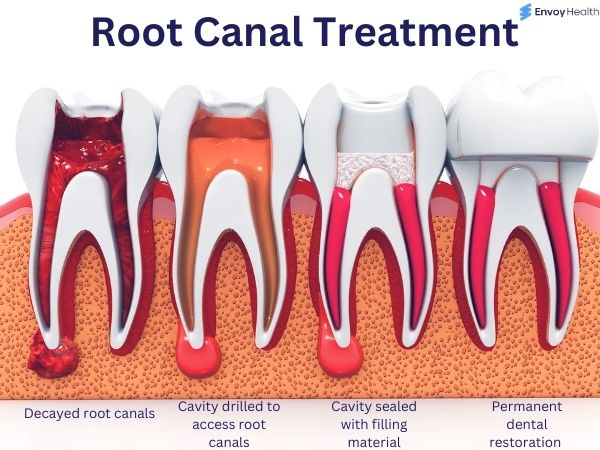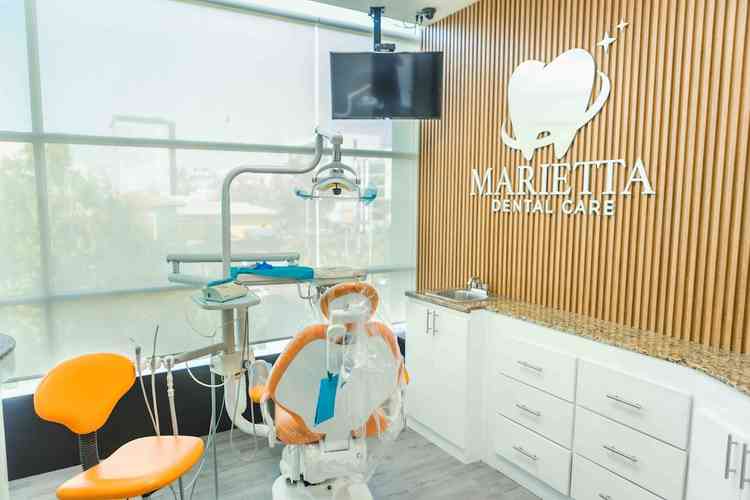Root Canal Versus Tooth Extraction: A Complete Guide to Saving or Removing Teeth

Prathyusha Itikarlapalli
- Content Writer

Table of contents
- Root Canal Basics
- Tooth Extraction Basics
- Both at the Same Time?
- Can a Dentist Extract a Tooth That Had a Root Canal?
- Root Canal vs. Tooth Extraction: Which Is More Affordable?
- Tooth Extraction vs. Root Canal: Which Hurts More?
- Root Canal vs. Tooth Extraction: Which Is the Better Choice?
- Key Factors to Consider Before Making a Choice
Key Takeaways
- The choice between tooth extraction and root canal therapy depends on factors, including the severity of the infection, the tooth location, the health of the gums and jawbone, the time required for the procedure and recovery, and budget considerations.
- Tooth extraction costs less than root canal treatment. However, RCT is a more significant investment in saving teeth and maintaining oral health.
- Tooth extraction is for decayed wisdom teeth or a severely decayed, cracked tooth where cleaning and disinfecting alone cannot clear the infection.
A throbbing toothache indicates underlying issues, such as cracks, tooth decay, or an advancing infection. Intensely decayed teeth become brittle and develop cracks. Dentists typically recommend either root canal treatment or tooth extraction to clear off the growing decay. The choice between these two treatments depends on the specific condition being treated. While the pain can significantly impact your quality of life, some adopt home remedies such as cold compresses and saltwater rinses. It's worth noting that home remedies can help alleviate pain and provide some relief. However, the growing infection requires appropriate treatment. Failing to do so, the bacteria may cause tooth abscesses or spread to other parts of the body, resulting in serious complications. A tooth decay spreading to the brain or heart can lead to death. It's better to opt for a root canal or tooth pull out, rather than avoiding the treatment by relying on over-the-counter pain medications.
A Brief Understanding of Root Canal Treatment
Root canal therapy (RCT) is an endodontic dental procedure performed to remove infected tooth pulp and bacterial debris. Dentists drill a tiny hole in the enamel of the infected tooth to access the soft pulp area inside. They use specialized files and reamers to clean the infected root canals. This is followed by sealing the cleaned root canals with gutta-percha and closing the cavity with dental restorations such as tooth crowns.[1] While every dental treatment has its pros and cons, we tabulated the positives and negatives in a table below.
|
Pros of the root canal procedure |
Cons of the root canal procedure |
|
Clears infection and prevents the bacterial spread to surrounding teeth |
Long procedure with multiple dental visits |
|
Offers relief from intense pain |
Possible complications such as a leak in the sealing or crown dislodgment |
|
Preserves the natural tooth so the adjacent teeth do not drift in or cause malalignment |
Chances of recurring infection and the requirement of repeated root canal procedures |

A Brief Understanding of Tooth Extraction
Tooth pulled out or extracted means deliberate removal from its socket or jawbone. Dentists initially loosen the tooth from its socket and remove it using forceps that are specifically designed for its shape. Generally, dental forceps vary in size and shape to offer a grip that suits teeth in the lower and upper jaw. In some cases, where a tooth is broken due to progressive underlying decay, dentists may remove it through surgical methods. Tools like luxators and dental drills are required to loosen the ligaments that hold the tooth to the jawbone.[2] Surgical extraction amounts to intense pain.
|
Pros of tooth extraction |
Cons of tooth extraction |
|
Shorter treatment time |
Permanent loss of the tooth |
|
Relatively less costs |
Leaves an empty socket into which surrounding teeth may drift |
|
Offers pain relief caused by problematic decay and a cracked tooth |
Although performed under anesthesia, the extraction causes significant pain and discomfort after the procedure as the anesthesia wears off |

Can You Undergo a Root Canal and Tooth Extraction at the Same Time?
One can undergo a root canal and tooth extraction at the same time on two different teeth. Which means a dentist can perform root canal treatment on a molar and an extraction for a canine on the same day. However, they do not perform both procedures for the same tooth at time. It's because root canal and extraction are two different procedures with varying intents. While both aim to clear the infection, one preserves the tooth, while the other leaves a missing space; therefore, it is not possible to have both procedures for the same tooth.
Can a Dentist Remove a Root Canal Tooth?
Yes, a dentist can pull out a root canal-treated tooth when it's suffering from persistent damage and decay. In fact, extraction is the last resort to treat root canal reinfection. In most cases, dentists consider a root canal retreatment to clear the infection. Root canal method is intended to save the tooth structure and preserve its functionality. However, dentists prefer extraction when the tooth develops a new infection and is spreading to adjacent oral parts.
Dentists will help you understand the positives and negatives of each procedure individually, allowing you to make an informed decision. Cost and associated pain are other considerable points that bother many patients. We have elaborated on them in detail below.
Is It Cheaper To Pull a Tooth or Root Canal?
Generally speaking, tooth extraction is less expensive than a root canal. When comparing root canal vs tooth extraction price in the US, the former costs between $500 and $3,000 while the latter costs $100 and $600. While you may wonder about the price difference, it's worth noting that the RCT preserves the natural tooth structure and is a time-intensive method, performed by an endodontic specialist. Furthermore, it requires sophisticated technology and dental restorations, such as crowns, which contribute to the “expensive” total treatment costs.
On the other hand, tooth extraction is a simpler procedure, performed in one visit, with minimal reliance on advanced technology. Typically, general dentists perform tooth extraction procedures, which lowers the fees.
Tooth Extraction or Root Canal Which Is More Painful?
It's natural for patients to compare root canal vs tooth extraction pain, when deciding on treatment. While dental treatments often trigger anxiety, modern anesthesia techniques make both options virtually painless during the procedure. The difference lies in recovery, with extractions often causing post-procedural discomfort once the anesthesia wears off. For severely decayed molars, a surgical extraction may be necessary, which can increase discomfort and prolong the healing period, too. On the other hand, root canal therapy typically involves minimal pain afterward.
Root Canal vs Tooth Extraction Which Is Better?
While the choice between root canal or tooth extraction can be challenging, it's worth noting that the decision depends on the specific condition. In most cases, opting for a root canal may be a wiser decision. Although root canal treatment can consume a bit of your time, getting the procedure will save your tooth and benefit your oral health. Additionally, it also avoids the necessity of additional procedures, such as dental implants, to replace the missing tooth with an extraction. This also lowers the treatment costs in an overall perspective.
However, this is different for teeth suffering advanced stages of decay. Generally, cavities deeper into the enamel and dentin weaken the tooth structure, and the tooth is liable to cracks and breaks. In such cases, a root canal may not be the wisest choice, as clearing the infection does not guarantee complete functionality. Extraction is a better option, followed by replacement with a dental implant or bridge. This helps you regain functionality while also maintaining aesthetics.
Factors That One Should Consider Before Opting for Extraction or Root Canal
Your dentist will help you decide between the two procedures based on your specific case. Consider the following factors when evaluating the root canal vs extraction pros and cons.
Tooth Location
The location of the tooth greatly influences the decision between root canal treatment and extraction. A root canal is usually preferred to preserve the appearance of front teeth. Molars in the early stages of decay are also good candidates for root canal therapy. However, in cases of severe damage, extraction may be the only option. When considering root canal vs extraction back molar or root canal vs extraction second molar, dentists carefully weigh chewing function, stability, and long-term outcomes.[3] In contrast, for root canal versus extraction wisdom tooth, extraction is often the favored choice, as wisdom teeth are harder to clean, more prone to complications, and less essential for chewing.
Gum and Bone Health Around the Tooth
A root canal is preferred to treat a decayed tooth supported by healthy bone and gum tissues. However, dentists perform an extraction for decayed teeth that are surrounded by diseased gums or jaws that have suffered significant bone loss. It's because performing a root canal for a tooth held improperly due to gum or bone issues cannot assure success. However, when the gum and jawbone are intact, dentists try to save the tooth using a root canal. It maintains bite alignment and functioning.
Tooth Infection or Abscess
Tooth infection or abscess relates to the intensity of bacterial action. Generally, a root canal is preferred to treat decay confined within the tooth structure. However, a bacterial infection that spreads to the surrounding gums and resulted in abscess formation requires a tooth extraction to prevent further spread.
Patient Comfort
Although pain is often a major concern for patients, dentists prioritize comfort above all else when deciding on the most suitable treatment approach. Both root canal and tooth extraction are carried out under anesthesia and do not cause much pain during the procedure. However, the level of post-procedural discomfort varies. Dentists should explain to patients the potential pain and discomfort that may follow extraction. This is more specific to the removal of broken wisdom teeth or molars, which may require surgical extraction. While simple extraction does not cause much pain, surgical extraction involves ligament tear, posing more post-procedural discomfort.
Time for Procedure and Recovery
While both the root canal procedure and tooth extraction are carried out on an outpatient basis, the timelines vary. The root canal procedure typically requires multiple sittings, whereas extraction is usually performed in a single visit. On the other hand, the healing process after a root canal is simpler compared to the healing process after extraction. Tooth extraction leaves an empty socket that requires a blood clot, heal, and regeneration of tissue and bone. Further, the healing takes even longer when stitches are involved.
Cost and Budget
Both are simpler procedures, but the root canal and tooth extraction costs vary. Patients need to know the costs of individual procedures along with the supportive treatments. While root canal costs may seem expensive, it can be a bigger initial investment. On the other hand, tooth extraction, although seemingly cheaper, may incur additional costs for an implant or a dental bridge, depending on the patient's condition.

Final Word!
Choosing between a root canal versus tooth extraction depends on several factors, including the extent of decay, tooth location, gum and bone health, infection severity, and patient comfort. While a root canal saves your natural tooth and maintains its chewing function, extraction may be necessary when the tooth is too severely damaged or infected to be saved. Considering costs, recovery time, and long-term oral health can help you make an informed decision. Always consult your dentist to determine the best option for your specific situation and protect your smile for years to come.
With expert guidance, personalized treatment options, and support every step of the way, Envoy Health makes it simple to choose the right care for your teeth and your smile. Sign up now to connect with trusted dental specialists, access cost estimates, schedule appointments with ease, and ensure your oral health is in the best hands. Don’t wait, protect your smile and make confident, informed decisions today.
References
Disclaimer
The information in this article is for educational purposes only and does not replace medical advice. Always consult your doctor before starting any treatments.
Yes, removing a tooth leaves affect the alignment of adjacent teeth in the long run. A missing tooth leaves an empty socket, and the surrounding teeth gradually drift into this empty space. Over time, this causes alignment problems and disturbs the upper and lower jaw teeth that fit together, finally leading to bite issues. Misaligned teeth are more prone to trapping food particles, making it harder to clean and increasing the risk of cavities.
Root canal treatment saves a tooth from decay in its early and middle stages. A tooth decay in its advanced stages or that has spread to nearby gum tissue or that has caused jawbone loss will require a tooth extraction. Getting a root canal might clean the infected pulp, but the risk of re-infection or the tooth developing cracks still exists.
The choice between root canal and extraction depends on the condition of the decay, the tooth's location, and budget expectations. A root canal preserves the original tooth structure and is beneficial in most cases. Extraction is still worthy considering for wisdom tooth decay or a severely decayed and cracked tooth.
Root canals and tooth extractions are closely related to oral health and are typically covered by most dental insurance plans. The percentage of coverage varies with insurance type and the choice of dentist, whether in-network or out-of-network.
A root canal heals faster compared to a tooth extraction. A tooth, when pulled out, leaves an open wound and is an invasive procedure. The empty socket that the extracted tooth leaves needs to heal with effective blood clot formation and tissue regeneration. This will consume a certain amount of time. A root canal, on the other hand, is a simple, minimally invasive procedure that causes minimal tissue damage. The healing time is relatively quick, with minimal post-procedural discomfort.
So, we partner with the premier healthcare facilities!
Send me the list








